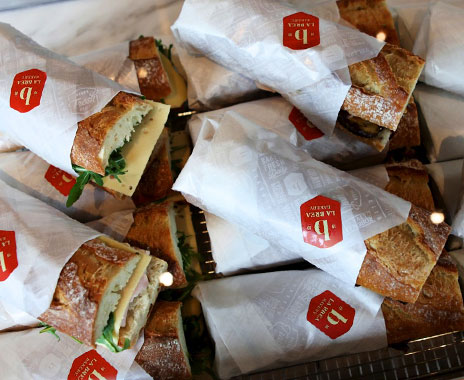La Brea Bakery rebranded itself for the first time in 25 years, updating its logo, packaging, and café to reflect its expanding vision while also doubling down on its commitment to supply fresh bread both to foodservice companies and consumers.
La Brea, which was originally built to supply a single restaurant and is now the largest artisanal bakery in the U.S., supplies restaurants and food retail around the world with fresh breads. It also operates two cafés and licenses a quick-service concept with sandwiches and baked goods.
The January grand re-opening of the flagship La Brea Bakery Café, an event that also celebrated La Brea’s 25th anniversary, showcased the company’s rebranding, which includes a new café model that features both table- and quick-service formats.
Just up the street from the original bakery on La Brea Avenue in Los Angeles, the new location, which is twice the size of the original, has casual service along with an express takeout counter. The glass-and-brick café has an old-world feel of home and hearth, with butcher-block tables, a stately wood-fired oven, and an entire wall of hollowed nooks filled with a tapestry of freshly baked bread loaves.
“When you look at [the café] and you see how grand it is, I just want to remind you all that the heart and soul of this beautiful place is really the bread,” founder Nancy Silverton said at the grand re-opening event. “It always will be. Some things never change, including our passion for perfection that you will always see and taste in our food.”
True to Silverton’s word, the first thing guests see when they walk into the café is the 35-foot display case lined with a colorful array of both sweet and savory baked goods, freshly prepared sandwiches, and wood-fired focaccia, pizzas, and breakfast frittatas.
Key to the rebrand, however, is La Brea’s new look for its packaging and products. Gone are the familiar burgundy striped bags with the iconic letter “B” logo crafted from pieces of dough. The new packaging has a bolder label and dons a bright red panel stamped with the new logo, a lower case letter “b.” At the letter’s center is the heart of La Brea Bakery: a loaf of bread.
There was never any grand vision for the bakery when it first launched, says La Brea CEO John Yamin. “Twenty-five years ago, Nancy made bread and pastries. That was her focus,” he says.
The bakery first opened to supply bread for Campanile, the restaurant Silverton opened with Chef Mark Peel. She taught herself to make artisan bread worthy of her high standards, and eventually the bakery took off faster than the restaurant. Wolfgang Puck was La Brea’s first restaurant customer, while Trader Joe’s was also an early client before the list of customers quickly grew. Yamin says the company grew “organically.”
“We expanded because our customers kept asking for it,” he says. “That’s the best way to grow—listen to what the customer is saying.”
It didn’t take long before the bakery had established itself as an L.A. fixture. Attracted by its local ties, Disney approached La Brea Bakery with the idea of opening a café in Disneyland’s Downtown Disney. That first café, which opened 11 years ago, is where many people experience La Brea Bakery bread for the first time. “We were lucky to grab that,” Yamin says.
Both cafés today, as well as the licensed stores, remain true to Silverton’s high standards, complementing the freshly baked breads with a wide variety of menu items. The café on La Brea Avenue offers salads, panini sandwiches, and burgers.
“Food’s not that hard and it shouldn’t be. That’s our approach,” Yamin says. “I’m not trying to create a restaurant to rival great chefs or fast food like McDonald’s or Subway. We supply them and support their model, but I want to be a lot simpler.”
It’s that clear vision that should make La Brea’s rebranding successful, says Brooke Burton, a Los Angeles–based restaurant consultant.
Rebranding can be a great thing to communicate a broader vision to customers, she says, but it’s important for an effective rebranding to have a clear idea of “who you are, what you sell, and how you sell it. Nancy Silverton’s organic discovery came out of her vision for great baked items. Rebranding helps communicate that original vision.”
Since the café’s grand re-opening, the customer base evolved to include a broader mix of people, Yamin says.
“I still get awed by it,” he says. “The original store had a loyal customer base, and now, there are tables with younger people and families, strollers. That’s pretty cool.”




